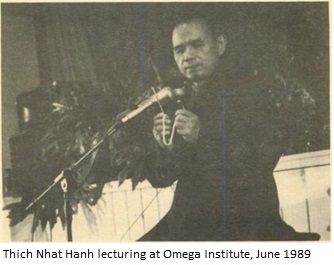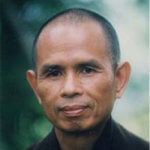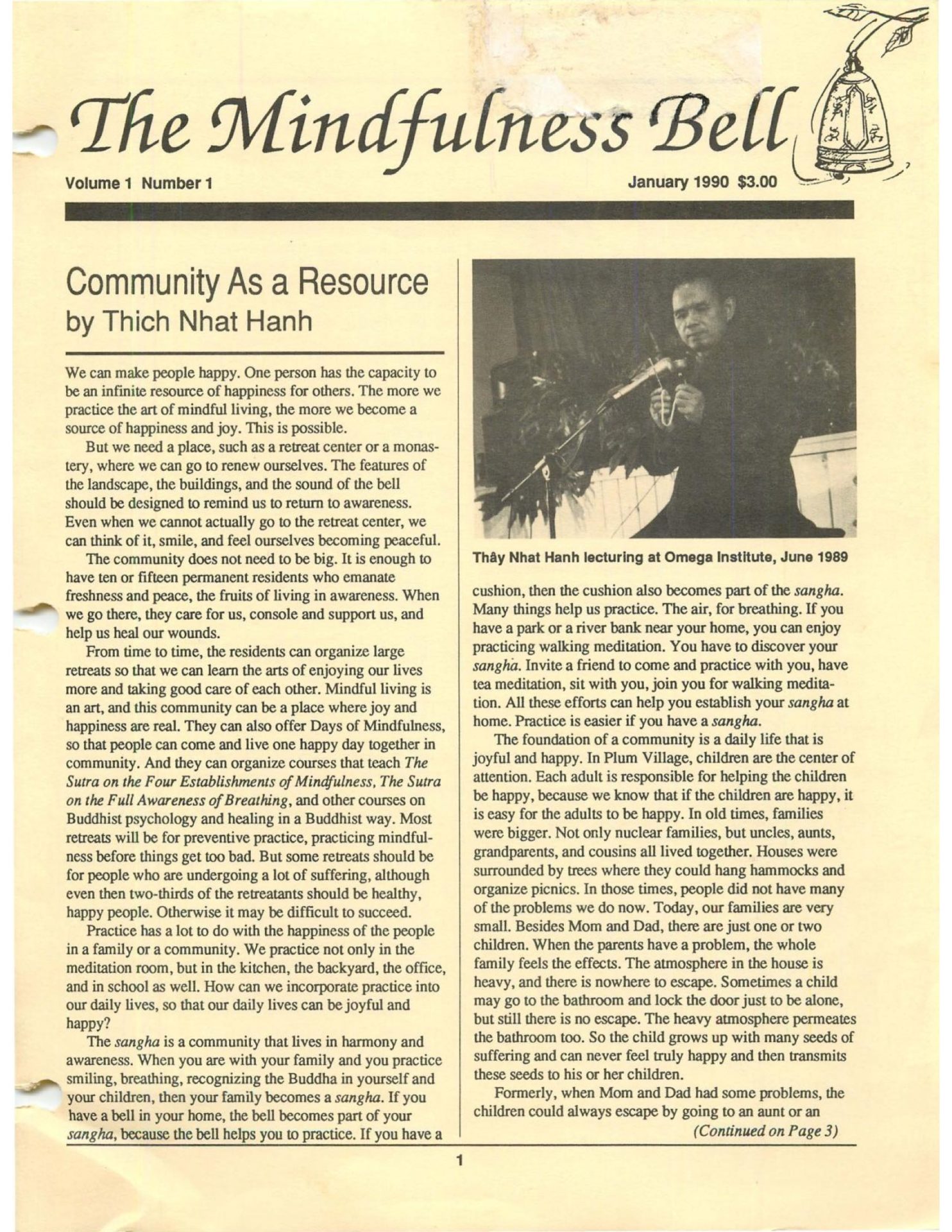
We can make people happy. One person has the capacity to be an infinite resource of happiness for others. The more we practice the art of mindful living, the more we become a source of happiness and joy. This is possible.
But we need a place, such as a retreat center or a monastery, where we can go to renew ourselves. The features of the landscape, the buildings, and the sound of the bell should be designed to remind us to return to awareness.

We can make people happy. One person has the capacity to be an infinite resource of happiness for others. The more we practice the art of mindful living, the more we become a source of happiness and joy. This is possible.
But we need a place, such as a retreat center or a monastery, where we can go to renew ourselves. The features of the landscape, the buildings, and the sound of the bell should be designed to remind us to return to awareness. Even when we cannot actually go to the retreat center, we can think of it, smile, and feel ourselves becoming peaceful.
The community does not need to be big. It is enough to have ten or fifteen permanent residents who emanate freshness and peace, the fruits of living in awareness. When we go there, they care for us, console andsupport us, and help us heal our wounds.
From time to time, the residents can organize large retreats so that we can learn the arts of enjoying our lives more and taking good care of each other. Mindful living is an art, and this community can be a place where joy and happiness are real. They can also offer Days of Mindfulness, so that people can come and live one happy day together in community. And they can organize courses that teach The Sutra on the Four Establishments of Mindfulness, The Sutra on the Full Awareness of Breathing, and other courses on Buddhist psychology and healing in a Buddhist way. Most retreats will be for preventive practice, practicing mindfulness before things get too bad. But some retreats should be for people who are undergoing a lot of suffering, although even then two-thirds of the retreatants should be healthy, happy people. Otherwise it may be difficult to succeed.
Practice has a lot to do with the happiness of the people in a family or a community. We practice not only in the meditation room, but in the kitchen, the backyard, the office, and in school as well. How can we incorporate practice into our daily lives, so that our daily lives can be joyful and happy?
The sangha is a community that lives in harmony and awareness. When you are with your family and you practice smiling, breathing, recognizing the Buddha in yourself and your children, then your family becomes a sangha. If you have a bell in your home, the bell becomes part of your sangha, because the bell helps you to practice. If you have a cushion, then the cushion also becomes part of the sangha. Many things help us practice. The air, for breathing. If you have a park or a river bank near your home, you can enjoy practicing walking meditation. You have to discover your sangha. Invitea friend to come and practice with you, have tea meditation, sit with you, join you for walking meditation. All these efforts can help you establish your sangha at home. Practice is easier if you have a sangha.
The foundation of a community is a daily life that is joyful and happy. In Plum Village, children are the center of attention. Each adult is responsible for helping the children be happy, because we know that if the children are happy, it is easy for the adults to be happy. In old times, families were bigger. Not only nuclear families, but uncles, aunts, grandparents, and cousins all lived together. Houses were surrounded by trees where they could hang hammocks and organize picnics. In those times, people did not have many of the problems we do now. Today, our families are very small. Besides Mom and Dad, there are just one or two children. When the parents have a problem, the whole family feels the effects. The atmosphere in the house is heavy, and there is nowhere to escape. Sometimes a child may go to the bathroom and lock the door just to be alone, but still there is no escape. The heavy atmosphere permeates the bathroom too. So the child grows up with many seeds of suffering and can never feel truly happy and then transmits these seeds to his or her children.
Formerly, when Mom and Dad had some problems, the children could always escape by going to an aunt or an uncle. They still had someone to look up to, and the atmosphere was not so threatening. I think that communities of mindful living can replace our former big families, because when we go to these communities, we see many aunts, uncles, and cousins, and that can help us a lot.
You know that aged people are very sad when they have to live separately from their children and grandchildren. This is one of the things in the West that I do not like very much. In my country, aged people have the right to live with the younger people. It is the grandparents who tell fairy tales to the children. When they get old, their skin is cold and wrinkled, and it is a great joy to hold their grandchild, so warm, so tender. When a person grows old, his or her deepest hope is to have a grandchild to hold in his or her arms. They hope for it day and night, and when they hear that their daughter is pregnant, they are so happy. Nowadays the elderly have to go to a home where they live only among other aged people. Just once a week they receive a short visit, and afterwards they feel even sadder. We have to find ways for old and young people to live together again. It will make all of us very happy.
A community of mindful living should be in a beautiful location in the countryside. In many cities today, you do not see a lot of trees, because so many trees have been cut down. I imagine—and I believe it is very close to reality—a city which has only one tree left. (I don't know what kind of miracle helped preserve that one tree.) Many people in that city have become mentally ill because they are so alienated from nature, our mother. In the old time, we lived among trees and we sat in hammocks. Now we live in small boxes made of concrete. The air we breathe is not clean, and we get sick, not only in our bodies but in our souls.
I imagine that there is a doctor in the city who understands why everyone is getting sick, and every time someone comes to him, he tells them, "You are sick because you are cut off from Mother Nature." And he gives them this prescription: "Each morning, take the bus and go to the tree in the center of the city and practice tree-hugging meditation. Hold the tree and breathe in, 'I am with my mother.' Then breathe out, 'I am happy.' And look at the leaves so green and smell the bark of the tree that is so fragrant." The prescription is for fifteen minutes of breathing and hugging the tree. After doing it for three months, the patient feels much better. But the doctor has many patients, and he gives each of them the same prescription.
So I imagine a bus in the city going in the direction of the tree, while people are standing in line, waiting their turn to embrace the tree and breathe. But the line is several miles long, and the crowd is becoming impatient because they have to wait for such a long time. They demand new laws which will limit each person to just one minute of tree-hugging. But one minute is not long enough to be effective, and then there is no remedy for society's sickness. I am afraid we will be close to that situation very soon, if we are not mindful of what is going on in the present moment.
When we practice mindful living, we know what is going on in every moment of our daily lives. When we throw a banana peel into the garbage, we know it is a banana peel, and that banana peels decompose quickly and become flowers. But when we throw a plastic bag into the garbage, we have to know that it is a plastic bag. This is a practice of meditation: "I am throwing a plastic bag into the garbage can." If we practice mindfulness, we will refrain from using things made of plastic, because we know that they take much more time to degrade into soil and become flowers. And we know that disposable diapers take four or five hundred years, so we refrain from using them. Nuclear waste, the most difficult kind of garbage, takes 250,000 years to become a flower. We are making the Earth an impossible place for our children to grow up.
Practicing mindfulness with friends allows us to get in touch with the healing aspects of life, Breathing mindfully the clean air, we plant seeds of healing within ourselves, our friends, and society. Smiling, we realize peace and joy. Communities of mindful living are very important for us to cultivate these practices.
Excerpted from Thich Nhat Hanh’s Lecture at the "Cultivating Mindfulness" Retreat, Mt. Madonna Center, Watsonville, California, April 1989.
To request permission to reprint this article, either online or in print, contact the Mindfulness Bell at editor@mindfulnessbell.org.


